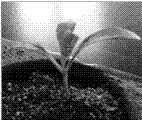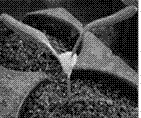A kind of breeding method of sugar beet with strong salt tolerance and drought resistance
A sugar beet and seed technology, which is applied in the field of strong salt-tolerant and drought-resistant sugar beet cultivation, can solve the problems of increasing the risk of beet hybrid plant diseases and insect pests, improving sugar content resistance, and limiting gene utilization potential, etc., to achieve sugar content High yield, strong salt and drought resistance, high sugar content
- Summary
- Abstract
- Description
- Claims
- Application Information
AI Technical Summary
Problems solved by technology
Method used
Image
Examples
Embodiment 1
[0026] Example 1: Agrobacterium-mediated wxya with ZxVP1-1 Genetically transformed sugar beets, see Figure 1~Figure 6 :
[0027] Genetic transformation mediated by Agrobacterium tumefaciens is currently the most commonly used, most studied, and most mature method. As early as 1974, Zeanen et al. discovered that when Agrobacterium tumefaciens infects plants, a piece of DNA on its plasmid can be inserted into the plant genome, thereby causing changes in plant genetic characteristics. Transformation of genes into plant genomes provides the basis. Since then, people have used the natural vector system of Agrobacterium tumefaciens to infect specific plant cells, introduce the target gene into the genome, and obtain transgenic strains with the help of cell culture technology to achieve the purpose of genetic transformation of exogenous genes (Hood et al., 1993 ). At present, Agrobacterium tumefaciens has successfully mediated the genetic transformation of most dicotyledonous...
Embodiment 2
[0031] Embodiment 2: the PCR detection of the target gene of transgenic sugar beet line, see Figure 7-Figure 8 :
[0032] Agrobacterium-mediated genetic transformation of exogenous genes to plants, mainly through the contact of Agrobacterium liquid with the target gene with the plant germ cells, using the natural infection characteristics of Agrobacterium to transfer the exogenous target gene into the explanted plant body. However, whether the exogenous gene mediated by Agrobacterium can be successfully transformed into the plant requires transgenic plants to provide evidence at the molecular level, which is an indispensable step for gene transformation and the most effective means to determine whether the target gene has been transformed ( Wang Guanlin et al., 2002).
[0033] Isolation of high-yield and high-quality DNA and RNA from plants is not an easy task due to the interference of cell walls and substances unique to plant cells. Therefore, when selecting materials, w...
Embodiment 3
[0043] Example 3: Physiological analysis of new transgenic beet lines with high salt tolerance and sugar content, see Figure 9~Figure 21 :
[0044] High concentrations of salt can cause ionic stress and osmotic stress to plants, seriously affecting the normal physiological and biochemical reactions of plants, resulting in slow growth or even death of plants. Although the gene of interest was detected in step 2 wxya with ZxVP1-1 It has been integrated into the sugar beet genome and overexpressed. However, whether it can improve the yield, phenotypic traits and salt tolerance of sugar beet in a saline environment is the focus of most attention, and it is also the ultimate goal of the present invention. Therefore, the present invention selects growth potential identical, target gene wxya with ZxVP1-1 The transgenic (T0) and wild-type (WT) sugar beet lines with consistent expression were treated with 1 / 2 Hogland nutrient solution containing 400 mmol / L NaCl respectively, a...
PUM
 Login to View More
Login to View More Abstract
Description
Claims
Application Information
 Login to View More
Login to View More - R&D
- Intellectual Property
- Life Sciences
- Materials
- Tech Scout
- Unparalleled Data Quality
- Higher Quality Content
- 60% Fewer Hallucinations
Browse by: Latest US Patents, China's latest patents, Technical Efficacy Thesaurus, Application Domain, Technology Topic, Popular Technical Reports.
© 2025 PatSnap. All rights reserved.Legal|Privacy policy|Modern Slavery Act Transparency Statement|Sitemap|About US| Contact US: help@patsnap.com



